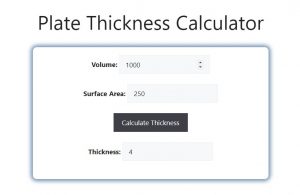About Plate Thickness Calculator (Formula)
Determining the appropriate thickness of a plate is essential in various engineering and construction applications. Whether you’re working on metal fabrication, structural design, or mechanical engineering, the plate thickness significantly affects the strength, durability, and performance of the final product. The Plate Thickness Calculator is a valuable tool that allows engineers and fabricators to calculate the necessary thickness based on volume and surface area. By understanding and applying this calculation, you can optimize material usage and ensure structural integrity in your projects.
Formula
The formula for calculating plate thickness is: T = V / SA, where T is the thickness of the plate, V is the volume of the material, and SA is the surface area of the plate.
How to Use
Using the Plate Thickness Calculator is simple. First, measure or determine the volume of the material you plan to use for the plate. Next, calculate the surface area of the plate based on its dimensions. Finally, input these values into the calculator, which will compute the thickness of the plate. This straightforward process helps ensure that you select the right thickness for your specific application, balancing strength and material efficiency.
Example
Let’s consider an example where you have the following values:
- Volume (V) = 1000 cubic inches
- Surface Area (SA) = 250 square inches
To calculate the plate thickness:
- Plug the values into the formula:
- T = 1000 / 250.
- Perform the division:
- T = 4 inches.
This result indicates that the required plate thickness is 4 inches, ensuring that the material can withstand the necessary load and stresses.

FAQs
- What is plate thickness?
Plate thickness refers to the distance between the two surfaces of a plate material, which impacts its strength and structural integrity. - Why is it important to calculate plate thickness?
Correctly calculating plate thickness is crucial for ensuring that structures can withstand loads without failing or deforming. - What do the variables in the formula represent?
T is the thickness of the plate, V is the volume of the material, and SA is the surface area of the plate. - How do I measure the volume of a plate?
The volume can be calculated by multiplying the plate’s length, width, and thickness. - What is surface area, and how do I calculate it?
Surface area is the total area of the exterior surfaces of the plate, typically calculated as length multiplied by width for rectangular plates. - What materials can I use this calculator for?
The Plate Thickness Calculator can be used for various materials, including metals, plastics, and composites. - Is there a maximum thickness that can be calculated?
There is no specific limit, but the calculations should remain practical and relevant to your engineering requirements. - Can this calculator be used for both 2D and 3D objects?
Yes, while primarily used for flat plates, the principles can apply to other geometries with adjustments for volume and surface area. - What happens if the plate is too thick?
A plate that is too thick may lead to increased material costs, weight, and potential challenges in machining and installation. - How can I adjust the thickness for different applications?
Consider factors such as load requirements, environmental conditions, and safety factors when adjusting thickness. - What industries commonly use plate thickness calculations?
Industries like construction, manufacturing, aerospace, and automotive frequently require plate thickness assessments. - Can I use the calculator for plates with varying thicknesses?
The calculator is best suited for uniform thickness plates; for varying thicknesses, you may need to perform separate calculations. - What tools do I need to measure dimensions accurately?
A caliper or measuring tape can be used to obtain precise measurements of length, width, and thickness. - How does temperature affect plate thickness?
Temperature changes can affect material properties, potentially requiring adjustments in thickness for thermal expansion or contraction. - What are some signs that a plate is insufficiently thick?
Signs include bending, warping, or cracking under load, indicating that the plate cannot withstand the applied stress. - How often should I recalculate plate thickness?
Recalculate whenever there are changes in design, material, or load conditions to ensure optimal performance. - Are there any online resources to assist with these calculations?
Yes, various engineering and manufacturing websites provide calculators and tools to assist with plate thickness calculations. - Can I rely solely on this calculator for critical applications?
While the calculator is useful, always consider consulting with a structural engineer for critical applications. - What additional factors should I consider in my calculations?
Consider factors such as material properties, load types, environmental conditions, and safety factors. - What is the impact of using thicker materials on overall design?
Thicker materials can enhance strength but may increase weight and cost, requiring careful consideration in design.
Conclusion
The Plate Thickness Calculator is a vital tool for engineers, fabricators, and designers, enabling precise calculations for optimal material performance and structural integrity. By accurately determining plate thickness based on volume and surface area, you can enhance the quality and reliability of your projects. Regularly using this calculator and considering all relevant factors will help you achieve the best results in your engineering applications, ultimately leading to safer and more effective designs. Embrace the power of accurate calculations to elevate your engineering practices and ensure material efficiency in your work!